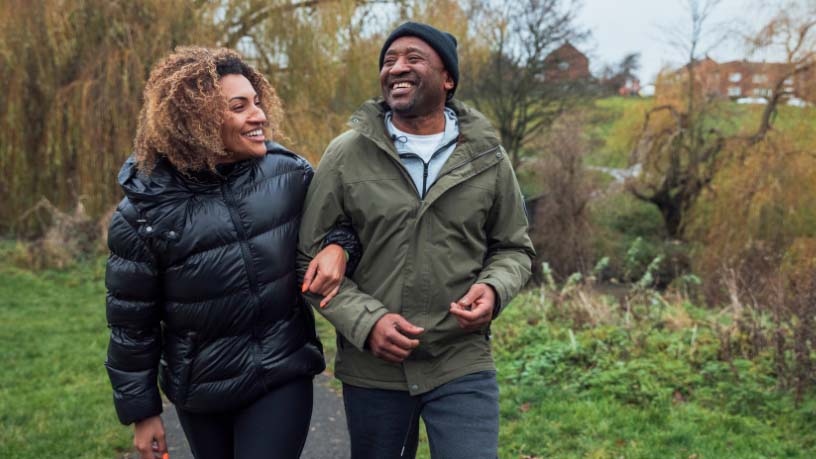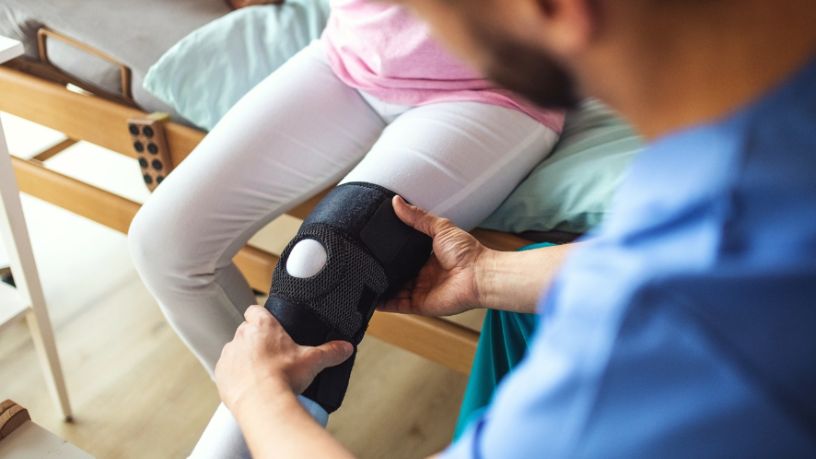A knee replacement or revision can help to ease pain and improve your mobility and quality of life.
On this page
Key takeaways
Surgery is usually recommended if other treatments have been unsuccessful.
Recovery takes time and rehabilitation is key.
Knee replacement surgery is common in Australia, with almost 70,000 people having the operation each year.1 Successful knee replacements can relieve serious, debilitating pain and improve your overall quality of life.
While knee replacements are common, they’re still considered a major surgery which is usually only performed after other treatments haven’t worked. This includes:
- weight loss
- exercise to improve mobility
- physiotherapy
- medication to treat pain.
It’s important to have an honest conversation with your treating team about the risks, benefits and alternatives to the operation.
What's the difference between a knee replacement and a knee revision?
Your knee joint is the largest joint in your body, connecting your thigh bone (femur) and shin bone (tibia). These normally glide over each other easily because they’re covered by smooth cartilage. This cartilage is a tough, flexible material that protects bones from joint friction and impact. If your cartilage is damaged by injury or worn away by arthritis, it can make your joint painful and stiff.
Knee replacement surgery replaces the knee joint with plastic or metal parts that can last up to 25 years.
However, knee replacement parts can become worn over time. A knee revision is an operation to remove and replace a damaged artificial knee joint. You might also need a revision surgery if infection has made the knee replacement unsuccessful.
Risks and complications of knee surgery
All surgeries have risks and the potential for complications, but knee surgeries are generally safe and are performed regularly around the world.
Potential complications can include:
- infection of the wound or joint. You’ll be given antibiotics during and after surgery to help prevent this
- damage to nerves or blood vessels. This is usually mild and temporary
- scar tissue. This can build up and restrict your movement.
It’s important to speak to your surgical team to understand your level of risk before surgery.
How to prepare for knee surgery
Weeks before surgery
The weeks before your knee replacement are a time to ensure you’re as mentally and physically prepared for the surgery as possible.
That means:
- asking your treating team any questions
- organising any equipment you might need (such as walking aids, shoehorns, grab bars and a raised toilet seat)
- ensuring you have enough support at home (you may need help with daily tasks like cooking, cleaning and washing and dressing yourself)
- preparing your home (such as removing clutter, preparing frozen meals and having plenty of ice packs)
- completing any physiotherapy (known as prehab) prescribed by your treating team to help build strength and prepare your body for recovery after surgery.
Your surgical team might ask you to:
- stop smoking
- adjust or stop some medications
- focus on weight management.
Days before surgery
By now, you should have a clear understanding of what you need to take to hospital and your home should be set up ready for your return.
If you’re someone who likes to be organised, you probably have a bag packed and ready to go with everything you’ll need for your hospital stay.
Recovery is different for everyone, but the first 6 weeks can be quite intense. You won’t have full function for a while, so it’s important you have some supports in place. That means having people to help with daily tasks, but also making sure you’ve picked up any supportive equipment you need.
Cooking and freezing some meals is a great way to make sure you don’t have to cook in those first few weeks. Doing a spring clean and removing clutter can also make your life easier when you come home.
To ensure everything goes smoothly on the day of your surgery, you need to be clear about:
- when to fast (stop eating and drinking) before your surgery
- what to bring to hospital (comfortable clothes, your phone and charger, toiletries, books, etc.)
- if there’s any paperwork or billing information you need to finish
- how long you’ll likely stay in hospital
- how to prepare yourself and your home for post-op recovery.
What to expect from knee surgery
During surgery
A knee replacement usually takes between 2 to 4 hours. Knee revision surgery can be more complicated because the existing artificial knee joint will need to be removed first.
These operations are usually performed under a general anaesthetic, so you won’t be awake during the surgery. You’ll usually be given antibiotics to help prevent infection.
During the surgery, the worn or damaged surfaces of the knee will be removed. After your surgeon has fitted the new joint, the wound will be closed with stitches or clips and covered with a dressing. Your surgeon will tightly bandage your knee to help reduce the swelling.
Immediately after surgery
When you wake up from the surgery, you’ll probably feel some pain and swelling, but you’ll be offered some strong pain relief.
You might be given medication to help prevent blood clots and may be asked to wear compression stockings. Calf pump cuffs or hourly foot and ankle exercises may also help keep your blood flowing.
You’ll be visited by a physio in hospital, who will help you get up and moving and guide you through daily exercises. These are designed to get your knee joint moving and strengthen your muscles. That might mean practising getting in and out of a bed and a chair, and practising walking (with support to start). Your physio will also give you some advice about caring for your knee and how to progress with your rehabilitation.
You’ll be in hospital until you can walk safely with the help of a walking frame, walking sticks or crutches. This could take a few days or maybe a week, as recovery is different for everyone. When you’re ready to go home, you’ll need someone to drive you. At this point you should have a pretty clear idea of what your rehab plan will look like and how to get back on your feet with the best possible results.
Recovering from knee surgery
Everyone’s recovery process is different, and your age, overall health and fitness level can all play a part.
Wound care
Your surgical team will give you specific instructions about how to look after your wound, but the general rule is to keep the area clean and dry.
You might also need to:
- clean and dress your wound daily (follow the instructions of your treating team)
- avoid soaking in a bath or swimming in a pool or the ocean until the wound has healed to reduce the risk of infection
- avoid scrubbing the site
- allow soapy water to run over the wound in the shower, rinse with clean water and gently pat dry.
If you have dissolvable stitches, they should disappear within about 6 weeks. Non-dissolvable stitches and clips are removed 10 to 14 days after surgery. Your treating team might also ask you to massage around the scar to prevent it from getting tight, which can limit knee movement and rehabilitation progression.
Medication
You may need to keep taking an anticlotting medicine after surgery. Make sure you finish the full course, as blood clots may form if they’re stopped too early. Wearing compression stockings for several weeks at home might also help to reduce your risk, as will continuing to stay as mobile as possible.
Depending on the level of pain you’re in, you might be prescribed pain relief medication, or you might choose over-the-counter painkillers like paracetamol or ibuprofen.
Rehabilitation
Ongoing rehabilitation is essential to help restore strength and movement in your knee. A physio will guide your rehabilitation at home, a clinic or a hospital-based rehabilitation unit.
Rehabilitation at home
If you didn’t have any complications and you’re able to get around with a walking aid, you should be able to do your rehab program at home. Your physio will guide you through exercises to build up strength and increase your mobility. Your rehab plan will change over time as you get stronger and are better able to get around.
Bupa Health Programs
Discover our programs designed to help you recover and stay out of hospital where you can.
Rehabilitation in hospital (inpatient)
If you need extra medical care, or if you don’t have the support you need at home, you might opt for inpatient rehab. This means staying in hospital or a rehabilitation centre, where you’ll be supported through your recovery program. As an inpatient, you’ll have access to other health professionals like rehab physicians, occupational therapists and nurses.
In the public system, inpatient physio is only for patients who aren’t well enough to go home, or don’t have enough support. As a private patient you might choose inpatient physio, but it will be an additional cost. Talk to your surgeon about what’s right for you.
Returning to daily tasks
While everyone’s recovery journey is different, the key to getting back on your feet as soon as possible is regular rehabilitation. The first 6 weeks after surgery are a particularly important time to make sure you’re moving (with support as you need) and building strength. It can take up to 3 months for pain and swelling to completely settle down, and sometimes up to a year for any leg swelling to disappear.
Depending on what you do for a living and how well you respond to your rehab, you could return to work between 6 to 12 weeks after surgery. You’ll need to talk to your employer to make sure you have all the support you need to get back to work safely.
When it comes to driving, it’s best to follow your surgeon's advice. Don’t drive until you’re confident that you can perform an emergency stop without any pain.
And remember, we’re all different. Try not to compare your experience to others. Instead, set your own rehabilitation goals with the support of your medical team.
Resources
Musculoskeletal Health Australia provides information and support for people living with arthritis and musculoskeletal conditions. Visit their website or call them on 1800 263 265.
Pain Australia works towards improving the quality of life for those living with pain. Visit their website for resources and support, including their National Pain Services Directory.
NSW Government Health’s Patient Roadmap is a handy step-by-step guide to preparing for and recovering from surgery.
The Australian Physiotherapy Association can help you find a physio near you.

At Bupa, trust is everything
Our health and wellbeing information is regularly reviewed and maintained by a team of healthcare experts, to ensure its relevancy and accuracy. Everyone's health journey is unique and health outcomes vary from person to person.
This content is not a replacement for personalised and specific medical, healthcare, or other professional advice. If you have concerns about your health, see your doctor or other health professional.
1Australian Orthopaedic Association National Joint Replacement Registry. (2023). Knees. Australian Orthopaedic Association.
You might also like...
7 things I wish I knew before knee surgery
Knee surgery is a major operation that may require months of intensive recovery. Discover 7 common insights from those who’ve done it.
What happens after an ACL injury?
An ACL injury can be painful, and may require medication, physiotherapy and even surgery. Get to know your options.
Knee pain: A basic guide
Your knees are the largest joints in your body. They’re also among the most accident prone. Get to know the basics of knee pain.
What you need to know before knee reconstruction surgery
Find out everything you need to know about knee reconstruction surgery and how to set yourself up for your best possible recovery.





